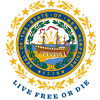Influenza-Like Illness Surveillance Network (ILINet)
Information and resources for the Influenza-Like Illness Surveillance Network (ILINet)
Influenza (flu) is not a reportable disease in New Hampshire (NH), yet surveillance (data) systems are in place to determine the extent of illness and the current virus types. Data from heathcare providers and laboratories, as well as data from other data systems, are examined, and this data is used to describe flu activity each week, in NH.
The Centers for Disease Control and Prevention (CDC) uses the data provided by ILINet providers each week to report the levels of ILI activity in each state in their Weekly Fluview Report.
New Hampshire participates in the U.S. ILINet Surveillance System, a collaborative effort between the CDC, the NH Division of Public Health Services, and healthcare providers throughout the state.
Influenza Surveillance ILINet Provider
An influenza ILINet provider (also commonly referred to as a sentinel provider) can be a health care provider (physician, physician assistant, nurse practitioner, nurse) in any of the following specialties: family medicine, internal medicine, pediatrics, emergency medicine, student health. Health care providers working in a private practice or in a public health clinic are eligible.
Data Collection and Reporting
ILINet sentinel providers conduct surveillance for influenza-like illness (ILI) in collaboration with the CDC and the NH Department of Health and Human Services. Data provided by ILINet providers are combined with other influenza surveillance data to provide a national picture of influenza activity in the US.
Each week, approximately 3,000 outpatient healthcare providers around the country participate in ILINet surveillance system.
ILINet providers report:
- The total number of patient visits each week and
- The number of patient visits for ILI by age group.
ILI is defined as
- 1) a fever of 100° F or more and
- 2) cough and/or sore throat.
These data are transmitted once a week to a central data repository at CDC via the Internet or fax.
Reporting is done during the traditional influenza season (October through mid-May), but continued reporting through the summer months is strongly encouraged. This helps determine baseline flu activity and may detect unusual influenza viruses that are circulating.
Laboratory Specimen Collection
Specimens for virus isolation are collected from a subset of patients at the beginning, middle and end of the influenza season, from unusual clinical, or unusually severe cases and from outbreak-related cases.
Specimens are sent to the Public Health Laboratories, and testing is done free of charge for sentinel providers. Aggregate influenza detections and total specimens are also tested by a number of hospital clinical laboratories.
Importance of Influenza Surveillance
Influenza viruses are constantly evolving and cause substantial morbidity and mortality each year.
The data from ILINet providers are critical for monitoring the impact of influenza and, when combined with other influenza surveillance data, can be used to:
- Guide prevention and control activities,
- Vaccine strain selection, and
- Patient care.
ILINet providers receive:
- Feedback on the data submitted,
- Summaries of regional and national influenza data, and
- A free subscription to CDC's Morbidity and Mortality Weekly Report and Emerging Infectious Diseases journal.
Participation by ILINet sentinel provider is a very important component of both CDC’s and NH’s public health surveillance system.
Interested in becoming a participating ILINet provider?
Contact the Influenza Surveillance Program at 603-271-6585.



